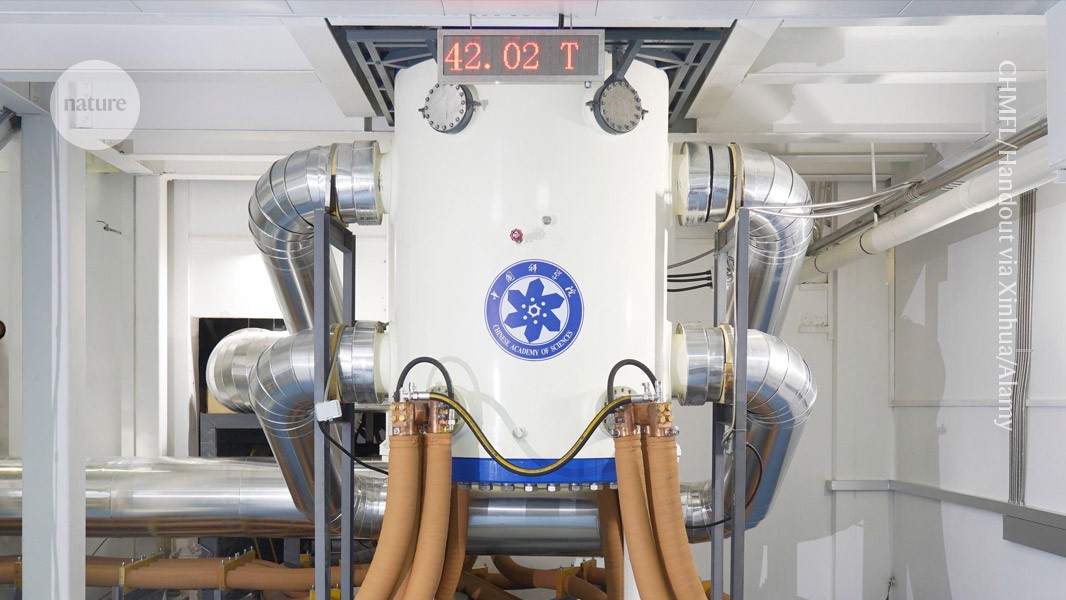
The resistive magnet at the Hefei Institutes of Physical Science.Credit: CHMFL/Handout via Xinhua/Alamy
China is now home to the world’s most powerful resistive magnet, which produced a magnetic field that was more than 800,000 times stronger than Earth’s.
On 22 September, the magnet, at the Steady High Magnetic Field Facility (SHMFF) at the Chinese Academy of Science’s Hefei Institutes of Physical Science, sustained a steady magnetic field of 42.02 tesla. This milestone narrowly surpasses the 41.4-tesla record set in 2017 by a resistive magnet at the US National High Magnetic Field Laboratory (NHMFL) in Tallahassee, Florida. Resistive magnets are made of coiled metal wires and are widely used in magnet facilities across the world.
China’s record-breaker lays the groundwork for building reliable magnets that can sustain ever-stronger magnetic fields, which would help researchers to discover surprising new physics, says Joachim Wosnitza, a physicist at the Dresden High Magnetic Field Laboratory in Germany.
The resistive magnet — which is open to international users — is the country’s second major contribution to the global quest to produce ever-higher magnetic fields. In 2022, the SHMFF’s hybrid magnet, which combines a resistive magnet with a superconducting one, produced a field of 45.22 tesla, making it the most powerful working steady-state magnet in the world.
Research tool
High-field magnets are handy tools for uncovering hidden properties of advanced materials, such as superconductors — materials that, under very low temperatures, carry electric current without producing waste heat. High fields also offer the chance to glimpse entirely new physical phenomena, says Marc-Henri Julien, a condensed-matter physicist at the National Laboratory for Intense Magnetic Fields in Grenoble, France. “You can create or manipulate new states of matter,” says Julien.
High fields are also useful for experiments that rely on very sensitive measurements, because they boost the resolution and make it easier to see faint phenomena, says Alexander Eaton, a condensed-matter physicist at the University of Cambridge, UK. “Every extra tesla is exponentially better than the last,” he says.
Guangli Kuang, a physicist who specializes in high magnetic fields at the SHMFF, says the team spent years modifying the magnet to hit the latest record. “It wasn’t easy to achieve,” he says.
Reliable but costly
Resistive magnets are an older technology, but they can sustain high magnetic fields for longer periods than can their newer hybrid and fully superconducting counterparts, says Wosnitza. Their magnetic fields can also be ramped up much quicker, making them versatile experimental tools. “You can just twist a knob and go from zero tesla to high fields within minutes,” he says.
The big drawback of resistive magnets is the amount of power they consume, making them costly, says Eaton. For instance, the SHMFF’s resistive magnet drew 32.3 megawatts of electricity to produce its record-breaking field. “You’ve got to have a very good science case to justify that resource,” says Eaton.
That challenge is driving the race to develop hybrid and fully superconducting magnets that can generate high fields with less power. In 2019, NHMFL researchers built a miniature, proof-of-concept superconducting magnet that briefly sustained a 45.5-tesla field, and are currently developing a larger 40-tesla superconducting magnet that can be used for experiments. The team at the SHMFF is building a 55-tesla hybrid one. Although these newer magnets are expected to be cheaper to run than their resistive counterparts, they come with their own hurdles: they are more expensive to build and require complicated cooling systems, says engineer Mark Bird, a co-leader of NHMFL’s magnet science and technology division. “The technology is still being developed, and the costs are not clear yet,” says Bird.


